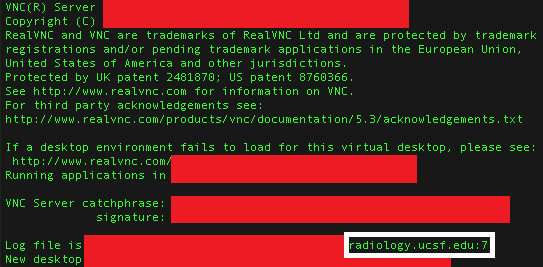VNC
Unlike SSH, VNC allows you to access a virtual display of the servers. This lets you browse through the file system and open visual applications such as Matlab and a web browser in a virtual operating system. Follow these steps to start a VNC session:
- Download and install VNC Viewer.
- Once installed you will need to SSH to the server to which you will VNC into and type the following command into a terminal:
myvncserver- Towards the bottom of the output, take note of the last number as that will be the display number you will need to access the VNC server. Shown as
radiology.ucsf.edu:7highlighted below.

-
Open VNC Viewer and type the server information in the following form:
- e.g.
servername.radiology.ucsf.edu:7 - You will be prompted for your UCSF username and password.
- e.g.
-
To change the resolution of the VNC display to match your monitor resolution type the following command into a VNC terminal:
xrandr- Choose a resolution from the available options.
- E.g. for 2560x1600 if it has index 11, type the following command into a VNC terminal:
xrandr -s 11
Advanced
- Refer to the Scientific Computing Services (SCS) official VNC tutorial for more advanced options (requires UCSF login)